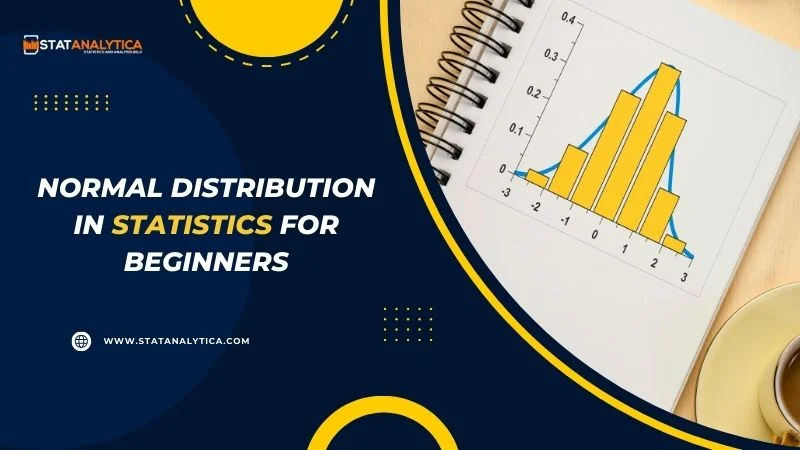Understanding normal distribution is a great place to start when you’re starting with statistics. Think of a pattern that shows up in everyday situations, like people’s heights or test scores, creating a bell-shaped curve. This is what normal distribution looks like—it helps us see how most values in a group are close to the average.
This guide on “understanding normal distribution in statistics for beginners” will explain what normal distribution is, why it matters, and how you can find it in real-life data. Let’s dive in and explore this important concept together!
What is Normal Distribution in Statistics?
Table of Contents
Normal distribution is a way to show how data is spread out, creating a bell-shaped curve. In this curve, most data points are near the average, with fewer points as you move away from the center.
For example, if you measured the heights of a large group of people, most would be close to the average height, and there would be fewer people who are very tall or very short. When you plot these heights on a graph, you get a bell-shaped curve.
Here’s what to know about normal distribution:
- Symmetry: The curve is the same on both sides of the center.
- Mean, Median, and Mode: These three values are all at the center of the curve.
- 68-95-99.7 Rule: About 68% of data falls within one step from the average, 95% within two steps, and 99.7% within three steps. This helps us see where most data points are likely to be.
Normal distribution helps us understand and predict patterns in many real-life situations. It’s a basic idea in statistics that makes working with data easier.
Step-by-Step Guide To Understanding Normal Distribution In Statistics For Beginners
1. Start with the Basics
- What is a Distribution?: A distribution shows how different values in a data set are spread out. It helps you see where most of the values fall.
- Normal Distribution: This is a type of distribution where data forms a bell-shaped curve around an average value.
2. Visualize the Bell Curve
- Draw a Bell Curve: Draw a curve that looks like a bell. The peak in the middle is where most of the data points are, and this peak represents the average.
- Symmetry: The curve should be the same on both sides of the peak. This means the data is evenly spread around the average.
3. Key Terms to Know
- Mean: The average of all data points. Add up all the values and divide by how many there are.
- Median: The middle value when you list the data points in order. In a normal distribution, the median is the same as the mean.
- Mode: The value that appears most often. For a normal distribution, the mode is also at the center of the curve.
- Standard Deviation: This tells you how spread out the data points are from the mean. A small standard deviation means the data points are close to the mean, while a large one means they are more spread out.
4. The 68-95-99.7 Rule
- 68%: About 68% of the data falls within one standard deviation from the average. For instance, if the average test score in a class is 80 and the standard deviation is 10, then 68% of students’ test scores will fall between 70 and 90.
- 95%: About 95% of the data falls within two standard deviations. So, heights would be between 160 cm and 180 cm.
- 99.7%: About 99.7% of the data falls within three standard deviations. Heights would range between 155 cm and 185 cm.
- Practice: Use these rules with sample data to see how they work.
5. Plot Your Data
- Create a Histogram: Collect your data and make a histogram to show how often each value occurs.
- Add the Bell Curve: Overlay a bell-shaped curve on your histogram to see if your data follows a normal distribution.
6. Find Normal Distribution in Real Data
- Look for Symmetry: Check if your data creates a bell-shaped curve.
- Use Tools: Use software like Excel, R, or Python to analyze your data and fit a normal distribution. These tools help you see if your data follows the bell shape.
7. Apply What You’ve Learned
- Real-Life Examples: Examine real-world data, such as test scores or heights, using normal distributions. This helps you make predictions and understand patterns.
- Make Predictions: Use the normal distribution to guess where most data points will fall based on the average and standard deviation.
8. Know the Limits
- Not Always Normal: Not all data fits a normal distribution. Some data might be skewed or follow different patterns.
- Other Distributions: Learn about different types of distributions for cases where normal distribution doesn’t fit.
9. Practice
- Solve Problems: Do exercises to practice working with normal distribution.
- Analyze Data: Look at different data sets to practice identifying normal distribution.
10. Review
- Summarize: Go over the key points about normal distribution, like its shape and the 68-95-99.7 rule.
- Ask Questions: If you’re unsure about anything, review the material or find more resources to help.
Visualizing Normal Distribution In Statistics
Seeing normal distribution in action can make it easier to understand. Here’s a simple way to picture it:
1. The Bell Curve
- Shape: Imagine a smooth, bell-shaped curve. The highest part of the bell is where most of your data points are, which is the average.
- Symmetry: The curve should look the same on both sides of the peak. This means your data is evenly spread around the average.
2. Key Parts of the Curve
- Mean: This is the middle of the curve where it is highest, showing the average value of your data.
- Standard Deviation: This tells you how spread out the data is from the average. It affects the width of the bell.
- One Standard Deviation: Lines one standard deviation away from the mean cover about 68% of the data.
- Two Standard Deviations: Lines two standard deviations from the mean cover about 95% of the data.
- Three Standard Deviations: Lines three standard deviations from the mean cover about 99.7% of the data.
3. Drawing the Bell Curve
- Mark the Mean: Put the average value in the middle of your graph.
- Draw the Curve: Create a smooth, bell-shaped curve that peaks at the average and slopes down on both sides.
- Add Standard Deviations: Draw lines at one, two, and three standard deviations from the average to show how the data is spread out.
4. Using Software Tools
- Excel: Use the NORM.DIST function to make a normal distribution curve.
- R: The dnorm function can help you draw the normal distribution.
- Python: Tools like matplotlib and scipy let you create and view the normal distribution curve.
5. Understanding the Curve
- Peak: The top of the curve shows where most data points are located.
- Spread: The bell’s width shows how spread out the data is. A wide bell means more, and a narrow bell means less.
- Probability Areas: The space under the curve shows probabilities. For example, about 68% of the data is within one standard deviation of the average.
6. Practical Example
- Example: If you have test scores and they form a bell shape, it means they follow a normal distribution.
- Using the Rules, You can see where most scores fall. For example, if the average weight of a batch of apples is 150 grams with a standard deviation of 12 grams, then about 68% of the apples will weigh between 138 grams and 162 grams.
How to Identify Normal Distribution in a Data Set
Here’s a simple guide to check if your data is normally distributed:
1. Know What to Look For
- Shape: The data should form a smooth, bell-shaped curve.
- Symmetry: The curve should be balanced on both sides of the peak, showing an even spread around the average.
2. Create a Histogram
- Make a Chart: Plot your data into a histogram, which shows how often each value occurs.
- Look for the Bell Shape: The histogram should look like a bell with the highest point in the middle.
3. Use a Q-Q Plot
- Generate the Plot: This chart compares your data to a normal distribution.
- Check the Line: If the points follow a straight line, your data is likely normally distributed.
4. Perform Statistical Tests
- Shapiro-Wilk Test: This test checks if your data is normally distributed. If the result (p-value) is more than 0.05, your data is probably normal.
- Kolmogorov-Smirnov Test: This test also compares your data to a normal distribution. A p-value above 0.05 suggests normality.
5. Look at Basic Statistics
- Mean, Median, Mode: These should be close or the same if your data is normal.
- Standard Deviation: Most of your data should be within a few standard deviations from the average.
6. Apply the 68-95-99.7 Rule
- Check Proportions: About 68% of your data should be within one standard deviation from the mean, 95% within two, and 99.7% within three.
- Compare: See if your data fits these percentages.
7. Examine Skewness and Kurtosis
- Skewness: Measures if your data is uneven. For normal data, this should be close to 0.
- Kurtosis: Measures how heavy the tails are. For normal data, this should be around 3.
8. Use Software Tools
- Excel: Use Excel to make histograms and run basic tests.
- R and Python: These tools can help create Q-Q plots, run tests, and calculate skewness and kurtosis.
Final Words
Understanding normal distributions in statistics is a crucial skill for beginners. It’s about recognizing the bell-shaped curve and knowing what it reveals about your data.
To see if your data fits this pattern, start by creating histograms and Q-Q plots. These tools will help you determine if your data forms a bell curve and if it’s evenly spread around the average. Also, check if most of your data falls within one, two, or three standard deviations from the average, as this is typical for a normal distribution.
By mastering these basics, you’ll have a solid grasp of understanding normal distribution in statistics for beginners. This will make interpreting data and tackling more complex statistical problems much easier.
Indicating the data is evenly spread around the mean. Kurtosis measures how heavy the curve’s tails are. For a normal distribution, kurtosis should be around 3, indicating moderate tails.
Note: If you are stuck with Statistics and need statistics assignment help, Feel free to contact us.. 🙂
How can Excel, R, or Python help?
Excel, R, and Python are useful tools for analyzing normal distribution. They can create histograms and Q-Q plots to visualize if your data follows a normal distribution. These tools can also run statistical tests to check for normality and calculate skewness and kurtosis.
What if my data doesn’t follow a normal distribution?
If your data doesn’t fit the normal distribution pattern, you might need to use different methods or transformations to analyze it correctly. Other distribution patterns might be a better fit for your data.
Is normal distribution suitable for all types of data?
Not all data follows a normal distribution. While many things do, some data fits other patterns like binomial or exponential distributions. It’s important to analyze your data to find the best-fitting pattern.


